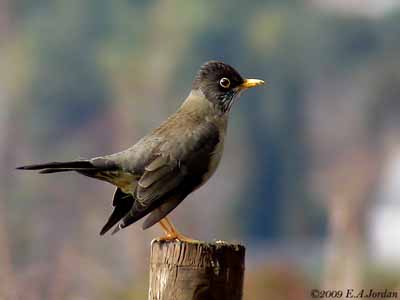
PROTECTION / THREATS / STATUS:
The Austral Thrush’s populations are not threatened at this moment, and classified as Least Concern.
The species is common in Chile and Argentina, and relatively abundant in Falcklands.
However, the introduced predators such as cats are an important threat for this thrush, in spite of the good breeding success.
Fr: Merle austral
All : Magellandrossel
Esp : Tordo Austral
Ital: Tordo australe
Nd: Magelhaenlijster
Photographers:
Eduardo Andrés Jordan
MIS AVES - AVES DE ARGENTINA
Philippe et Aline Wolfer
OISEAUX D’ARGENTINE
Texte de Nicole Bouglouan
Sources:
HANDBOOK OF THE BIRDS OF THE WORLD Vol 10 by Josep del Hoyo-Andrew Elliott-David Christie - Lynx Edicions - ISBN: 8487334725
THRUSHES by Peter Clement and Ren Hathway – HELM - ISBN: 0713639407
L’ENCYCLOPEDIE MONDIALE DES OISEAUX - Dr Christopher M. Perrins - BORDAS - ISBN: 2040185607
XENO-CANTO – Sharing Birds sounds from around the world
Austral Thrush
Turdus falcklandii
Passeriforme Order – Turdidae Family
BIOMETRICS:
Length: 23-26 cm
Weight: 85-113 g
DESCRIPTION:
This beautiful thrush is resident in the southern parts of South America and on Falckland Islands. Very similar in behaviour to our Common Blackbird, it has however different calls and song.

Adults of nominate race “falcklandii” (not displayed) have brown-olive upperparts. Flight feathers and rectrices are darker.
Underparts are buff-brown to ochre-brown, except chin and throat which are finely streaked blackish and buffy.
The head is blackish-brown to below the eyes.
The strong, pointed bill is orange-yellow. Eyes are dark brown with yellow eye-ring. Legs and feet are orange-yellow.
Both adults are almost similar.
The juvenile resembles adults but it has heavy buff-streaked upperparts and buffy-yellow underparts spotted dark brown.
Adult “magellanicus” (displayed here) is smaller than nominate.
It has olive-brown upperparts, but paler and greyer than “falcklandii”.
Underparts are paler with whitish chin and throat, more heavily streaked blackish. The undertail-coverts are paler with dark brown spots.
The head shows blackish forehead and crown.
Bill is yellow. Eyes are dark brown with narrow yellow eye-ring. Legs and feet are yellow.
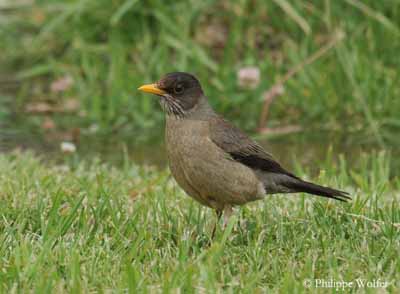
The female is slightly paler than male.
The juvenile resembles adult with dark brown head, brown upperparts with yellowish-buff streaks and pale buff tips to wing coverts.
Underparts are spotted dark brown.
Bill, eye-ring, legs and feet are pale yellowish.
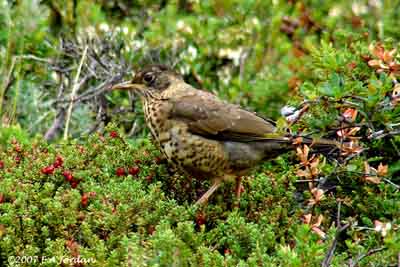
We can find three subspecies, but only two are recognized.
T.f. falcklandii from Falckland Islands.
T.f. magellanicus from S and C Chile and the Juan Fernandez archipelago, S to Tierra del Fuego, and S Argentina.
The subspecies T.f. mochae, from S Chile (Mocha Island), is slightly paler than “magellanicus” and with longer bill.
However, this bird is considered as insufficiently differentiated, and only the two first races are recognized.
VOICE: SOUNDS BY XENO-CANTO
The Austral Thrush’s typical calls are low-pitched “uiiit”, some harsher rattles “wreet” or “sreep”, and sharp “trrrt trrrt”.
The alarm call is a stronger and deeper “choyz-choyz-choyz”.
On the breeding grounds, it gives some deep, harsh “skwuk” or “squack” at intruders during territory defence.
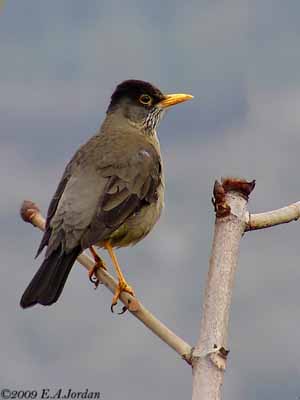
The song is uttered from exposed perch, often tree top, and well into night. This song can be considered weak and rich. It includes sustained series of measured warbling phrases, repeated several times such as “juiep tiele churi juiep cheee”. It may perform occasional mimicry.
On the Falckland Islands, the song is also given from various perches and varies in quality, becoming more plaintive, with slow series of whistles and harsh chuckles, alternating with low whirring.
During the courtship displays, we can hear a low buzzing “chiz-chiz”.
HABITAT:
The Austral Thrush frequents open understorey of Nothofagus antarctica forest to open forests and various wooded areas. It is also seen in brushy country and cultivated areas with some scattered trees and hedges, and also occurs in gardens.
This species can be seen from sea-level up to 2150 metres of elevation.
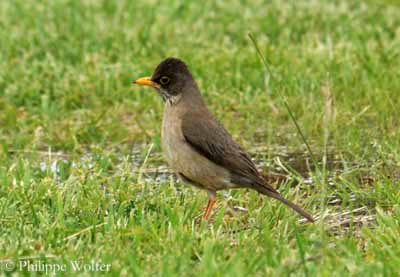
RANGE:
The Austral Thrush is found in southern S America, from S Argentina and S and C Chile to Tierra del Fuego, and on Falckland Islands.
BEHAVIOUR:
The Austral Thrush, as numerous Turdidae species, feeds on worms and snails, and also arthropods, insects’ larvae and pupae. It also takes fruit and berries from several plant species during winter, and household scraps such as bread. In frosty weather, it can frequent the birds’ feeders.
This thrush feeds mainly on the ground where it hops and runs while searching for preys on grassy lawns and pastures. However, it prefers soft soils in shady places.
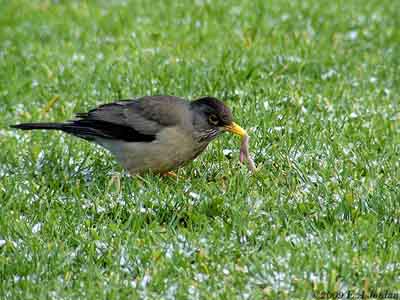
On the Falcklands, it has been seen killing Blackish Cinclodes (Cinclodes antarcticus) and Grey-backed Storm-petrels (Garrodia nereis). It usually forages on boulder beaches among dead kelp.
Courtship displays are poorly known. But some observation shows one or two males pursuing one female by running on the ground among grasses.
This species is territorial and monogamous. The territory is established by the male, and then, the female bonds with him. Usually, the male defends the area while the female builds the nest.
The Austral Thrush is often seen alone or in pairs, hopping and running on the ground while feeding.
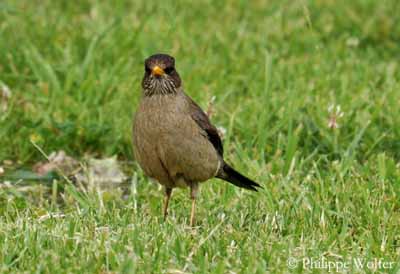
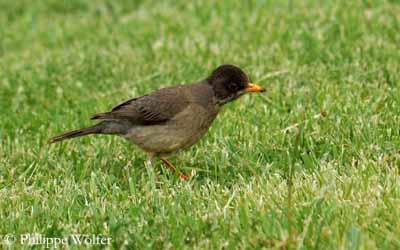
The species is sedentary but may perform some movements and dispersions in winter on mainland, about 3 to 6 kilometres over some months.
FLIGHT:
The Austral Thrush performs fast and undulating flight.
REPRODUCTION:
The breeding season occurs between September and February in Chile, in October-November in Argentina, and between August and December in Falckland Islands.
This species can produce 2-3 broods per season, sometimes 4 in Falcklands.
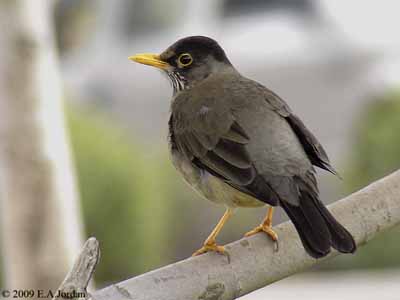
In Falcklands, the nest is placed in a crevice among the rocks, on bank sheltered by grass or in bush. It is a large, deep cup, made with dry grass stems, root fibres and occasionally wool or string. The interior is walled with mud or dung, and lined with grass or horsehair.
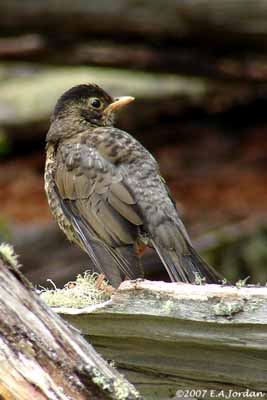
Female lays 2-3 blue-green eggs with dark markings. Incubation lasts about two weeks, mainly by female while the male patrols in the surroundings. The chicks are fed by both parents and fledge at 16-18 days of age.
A new brood may start 12-14 days later.
DIET:
The Austral Thrush feeds mainly on worms and snails, and numerous arthropods including insect larvae and pupae.
It also takes fruits and berries, and favours the strawberries.
It frequents the bird feeders and readily takes household scraps in some parts of the range.
